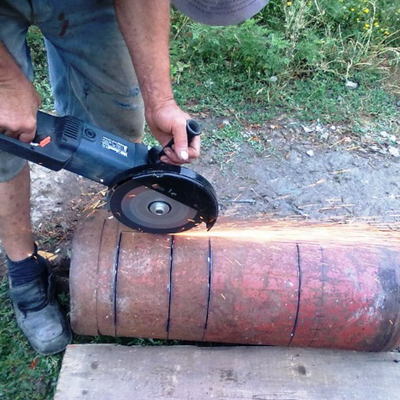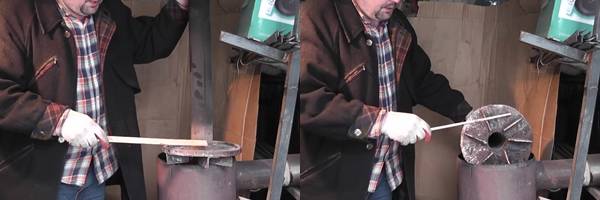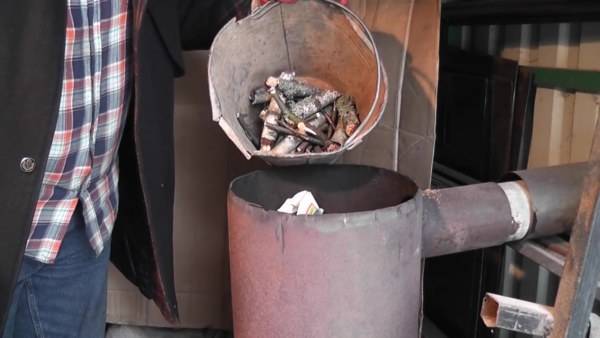Tools and materials
Let's talk a little about the materials used. If you want to assemble a Bubafonya stove with a water jacket with your own hands, make sure that the thickness of the walls of the combustion chamber is 4-6 mm. The shirt is made in two ways - by scalding the main body with sheet iron to form a heating circuit or by wrapping it with a metal pipe. If the stove heats the premises in a direct way, then the thickness of the walls does not really matter - an old barrel is quite suitable, only without through corrosion.
As for the tools and auxiliary materials necessary for assembling the Bubafonya stove, we will need:

The most dangerous part of the work associated with making a stove is, of course, everything where the grinder is involved. Using it, you need to be as careful as possible.
- Welding machine - for cutting and welding of individual elements;
- Grinder (angle grinder) - for cutting and processing metal edges;
- Hacksaw for metal - for working with small elements;
- Pipes of the diameter indicated in the drawing;
- Condensate drain cock;
- Hammer;
- Sheet metal 2-3 mm thick.
We have five stages of assembling the Bubafonya stove:
- Site preparation;
- Working with a barrel (gas cylinder);
- Preparation of the pressure circle;
- Chimney preparation;
- Assembly and first launch.
Let's go through these stages in more detail.
Furnace modernization, efficiency increase
There are three main ways to increase the efficiency of the stove: one of them is associated with the chimney, the second is with fuel, and the third is with the operating conditions.
Optimization of the chimney design
For the chimney, as already noted, a pipe with a diameter of 15 cm and a length of 5 m is used. And the furnace itself will operate at a reduced efficiency. To adjust the draft, a valve is arranged in the pipe. A door is created at the bottom of the chimney for easy cleaning.
Condensation forms and accumulates in any pipes. And in pipes during pyrolysis, it turns out even more, since the gases, having parted with all their heat, at the exit have negative temperatures. This trend becomes the reason for high-quality pipe insulation. The sandwich technology perfectly copes with this task. Its essence: a second is introduced into one pipe, and a thermal protection layer is made between them.

You can also make a sandwich pipe with your own hands by wrapping the chimney with insulation material and protecting the structure with an outer pipe.
In areas where pipes pass through the roof, it is necessary to perform thermal insulation using a metal box filled with insulation. A deflector is placed on the pipe head. It prevents precipitation from entering the system and also protects against the effects of wind.
If the place of installation of the stove is a stoker, there is no need for a reflector. When the stove is located in a room, the masonry surrounding it performs two functions:
- Protective screen for walls and things.
- Heat accumulator.
Since the body is made of metal, the furnace heats up and cools down rapidly. Cooling occurs immediately after the fuel burns out. Therefore, a brick screen, created on three sides of the stove, stores heat and releases it over time. As a reflector, you can use corrugated board or a smooth metal sheet.
What fuel is best used in long burning stoves
The efficiency of the furnace also depends on the fuel used. It is best to use dry logs.But since the stove is homemade, you can also save on fuel. The device can work even with natural debris.
Experts recommend using pellets (granular fuel) created by dry pressing in such stoves. The basis for pellets can be:
- cones;
- chips;
- sawdust;
- nutshell;
- straw.
Coal gives a good combustion temperature. But its use is justified when the oven is made only of materials with a decent thickness. Otherwise, such a unit will quickly burn out. A guideline can be a table showing the specific heat transfer of various materials.
Table: specific filling factor and specific heat transfer of various types of fuel
| Solid fuel type | Specific bookmarking factor, kg / dm3 | Specific heat transfer, kW / h |
| Aspen standard size | 0,143 | 2,82 |
| Coniferous shavings or sawdust | 0,137 | 3,2 |
| Alder pellets | 0,285 | 3,5 |
| Coal grade DPK | 0,4 | 4,85 |
| Coal grade SSOM | 0,403 | 5,59 |
| Large fraction anthracite | 0,5 | 5,72 |
| Peat briquettes | 0,34 | 2,36 |
Design

Workshop, nothing special: a metal frame made of a profile pipe sheathed with a corrugated sheet, a single-pitched roof, a galvanized corrugated sheet. The room was not insulated with anything, it is cold.
And this is our stove, and it is made according to the bubafoni principle. I took a fifty-liter gas cylinder, cut off the upper part, and it turned out to be a lid. There are two handles on the lid for convenience, a hole for the piston tube and a strip welded, along the perimeter a strip for sealing with the lower part is welded. In the upper part of the cylinder we make a hole for the smoke outlet and weld on the pipe for connecting the chimney.
The most difficult part to manufacture for a long-burning stove is the piston. We weld a round sheet metal penny to a metal pipe, it is three millimeters. It is better to reinforce the edge from warping from high temperatures. The twelfth square is welded.

Bottom part.
The corners are welded here, they are like additional stiffeners and provide the necessary clearance between the wood and the piston itself. Through this hole, air enters the combustion area.
About firewood. Than the bubafonya is drowned
We use any wood, including plywood, hardboard, sawdust, etc. At the very bottom we put the most dry firewood, so that at the end the combustion is maximum and everything that smoldered before is burnt out.
In the middle part, everything is in a row: this is cardboard, again, the boards are dry, there are sawdust, hardboard, chipboard, that is, everything is mixed. There are also packages, when we put things in order under the shed, garbage, sawdust, chips, small branches accumulate, we also send. A dry branch fell from the tree, broke it too.
Main characteristics and advantages of long burning furnaces
Self-created long-burning stoves can operate on the following types of solid fuels:
- firewood;
- coal;
- sawdust.
The cost of fuel cells is low. For this reason, they are very widespread. It is the long-burning wood-burning stove that has gained great popularity among homeowners. It is created at home, called "bubafonei".
What is a long burning oven
There may be slight differences in the designs of long-burning furnaces. But the principle of their functioning is similar - it is the production of heat energy during pyrolysis (not by the open flame method), when the wood is exposed to an impressive temperature with a limited amount of oxygen. And the fuel smolders, forming a hot gas. It includes:
- methane;
- hydrogen;
- carbon monoxide;
-
other elements.
Pros and cons of long burning stoves
The use of solid fuel long-burning stoves in the heating system of premises helps to eliminate almost all the shortcomings inherent in standard designs on similar fuels:
- Pyrolysis units are characterized by higher efficiency when compared with classical modifications.
- Long burning stoves do not need to be constantly loaded with wood or coal.
- The pyrolysis system can be automated.
There is a small caveat to the latter advantage. When a home-made apparatus that generates heat is used, the need for automation usually disappears, since even one load of fuel cells guarantees uninterrupted operation for 20 hours.
Design features of pyrolysis ovens
Combustion in a pyrolysis oven is characterized by low dynamics and high efficiency. It is supplied with air by means of a regulator. When the fuel cells are completely burning (approximately 20 minutes after loading), the air supply hole must be closed. This minimizes the passage of oxygen.

The main contribution to the generation of heat in the pyrolysis furnace is made by flue gases, which are located in a special sealed compartment.
The fuel smolders and is almost completely converted to gas. And the flue gases are concentrated in the ignition compartment. When they burn out, a lot of heat is generated. If you try to implement this method of combustion in a conventional furnace, directing its operation to the smoldering mode, you can seriously damage your own safety. In the best case, gases will rush into the chimney. At worst, they will find themselves in the room, bypassing the doors with weak tightness.
Weak sides
Despite all the advantages, the Bubafonya oven, like any other equipment, has a number of disadvantages:
- Low efficiency. The device is designed in such a way that it is mainly the metal of the body in certain places that heats up, and not the entire area of the boiler. Because of this, a low level of heat transfer is obtained. When compared with such stove devices as Buleryan and Butakov's Stove, the efficiency of Bubafoni is far behind them.
- Unpresentable appearance. Often, such a device is associated with a barrel from films, around which African-American poor people bask.
- Inconvenient way to clean the structure from combustion products, ash, soot. They have to be removed through the top of the case. The improved model solves this problem due to the presence of a grate and the addition of a door at the bottom of the body, through which ash is removed.
Variety of boilers
The Bubafonya boiler from a barrel is not the only option. In addition, the circular cross-section of the furnace, although it is optimal, is not considered a strict requirement. Such a boiler can also be made from rectangular metal sheets by welding them together. If there is no barrel, a large diameter pipe can be used. That is, there are a huge number of variations on the theme of the forms of the Bubafon boiler. The only condition is the height, which must be greater than the width of the device. And the higher the stove, the longer the used fuel will smolder.
Finished long burning oven
Other design changes include a pipe that is welded to a pressure weight. It doesn't have to be round. If you have corners left from building a house, then you can weld a square pipe from them. You just have to make a square hole in the pancake for it. This is the first thing.
Second, in order to facilitate the process of cleaning Bubafoni, you can make a rectangular hole in its lower part by installing a door on it.
It is important to ensure high-quality sealing here. Sometimes insufficient experience does not allow this, so that it is possible to operate the boiler without such an opening, thereby reducing the risk of fire
If you nevertheless decide to do this, we recommend using an asbestos cord as a seal.
Let's talk about the pros and cons of bubafoni.
Let's start with the disadvantages.
We believe that the very first and significant drawback is what we ourselves saw: during ignition, most of the smoke enters the room. There is forced ventilation in the workshop, and besides, there are so many cracks that the smoke will quickly evaporate, and in living quarters, or in rooms with poor ventilation, I would not install such a stove.
The second disadvantage is the inconvenience of cleaning the stove. To clean it, you need to completely disassemble it, disconnect it from the chimney, turn the cylinder over and shake out the ash. This is inconvenient and troublesome. Another drawback is that it probably applies to all metal stoves, that is, the stove gives off heat only when combustion occurs. Burning stops - the stove cools down instantly.
Advantages.
On the other hand, the metal stove heats up quickly and quickly heats up the room. Smoothly moved on to the pluses. And the most significant advantage, due to which you can close your eyes to the shortcomings, is that the furnace is long burning.
The next point concerns firewood. As I said already, any wood, plywood, hardboard, sawdust, I burn cardboard, chips, that is, everything that would never heat a brick stove in a house is suitable.
The next plus is the simplicity of the design and its low cost. I spent only on a gas cylinder, bought second-hand steel on the basis of second-hand, and it cost 400 rubles. Everything else: pipes, materials, components, were found on the farm.
The stove intensively emits heat, and in order to disperse this heat faster around the workshop, we use a fan.
In conclusion, we note that the master is generally satisfied with the stove. It was interesting to try what the “bubafony” construction is. And we can say that the stove has a right to exist!
Good luck to all!
Canal “Two Vegetables”.
Heating the garage
Advantages and disadvantages of the oven
A simple-looking stove combines many important advantages, among which the following points must be noted:
- Extreme simplicity of design. Almost anyone can handle the assembly of bubafoni.
- Profitability. Depending on the volume of the firebox and the quality of the raw material, the bubafonya can operate on one load for up to several days.
- Unpretentious care and handling. After firing up the fuel, the bubafon can be left unattended for a long time and go about his business (but it is better, nevertheless, to periodically check the condition of the unit), and all the care of the stove comes down to periodic cleaning of the ash pan and chimney.
- No expensive and hard-to-find materials are needed to assemble a bubafoni. A tank, a lid, a few pipes and various simple metal products will be enough.
- The stove perfectly copes with its main task even in very severe frosts.
- Bubafonya can be used to heat a residential building, greenhouse, garage, country house and other objects.
- The unit is characterized by a high rate of fire safety - there are no openings in its design for an open flame.

Despite the obvious advantages, this stove also has disadvantages:

Another important drawback is not the most attractive look.
If the bubafon is used in a technical room - in a garage, a greenhouse, in a country house, then there is nothing to worry about. As it is, so it is.
Well, if you want to use it to heat the house, you will have to hide it somewhere in the boiler room, basement, in an extension.
You can still refine it. For example, brick it. By this, by the way, you will greatly increase the comfort of being near the stove: the brick will extinguish most of the hard radiation, soften it, and become a kind of heat accumulator: the brick will heat up, and then, when the stove goes out, it will gradually cool down and give off the accumulated heat.
